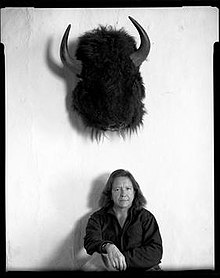Fritz Scholder
| Fritz Scholder | |
|---|---|
 |
|
| Born |
October 6, 1937 Breckenridge, Minnesota |
| Died | February 10, 2005 (aged 67) Scottsdale, Arizona |
| Nationality | Luiseño, American |
| Movement | Abstract Expressionism |
Fritz Scholder (October 6, 1937 – February 10, 2005) was a Native American artist. Born in Breckenridge, Minnesota, Scholder was one-quarter Luiseño, a California Mission tribe. Scholder's most influential works were post-modern in sensibility and somewhat Pop Art in execution as he sought to deconstruct the mythos of the American Indian. A teacher at the Institute of American Indian Arts in Santa Fe in the late 1960s, Scholder influenced a generation of Native American students.
Scholder knew what he had to do at an early age. As a high school student at Pierre, South Dakota, his teacher was Oscar Howe, a noted Yankton Dakota artist. In the summer of 1955, Scholder attended the Mid-West Art and Music Camp at the University of Kansas. He was voted Best Boy Artist and President of the Art Camp. He studied with Robert B. Green at Lawrence. In 1956, Scholder graduated from Ashland High School in Wisconsin and took his freshman year at Wisconsin State University in Superior, where he studied with Arthur Kruk, James Grittner, and Michael Gorski. In 1957, Scholder moved with his family to Sacramento, California, where he studied with Wayne Thiebaud. Thiebaud invited Scholder to join him, along with Greg Kondos and Peter Vandenberg in creating a cooperative gallery in Sacramento. Scholder’s first show received an exceptional review. Scholder’s next one-man exhibition was at the Crocker Art Museum in Sacramento. His work was being shown throughout the region, including the California Palace of the Legion of Honor in San Francisco. Upon graduation from Sacramento State University, where he studied with Tarmo Pasto and Raymond Witt, Scholder was invited to participate in the Rockefeller Indian Art Project at the University of Arizona in 1961.
...
Wikipedia
